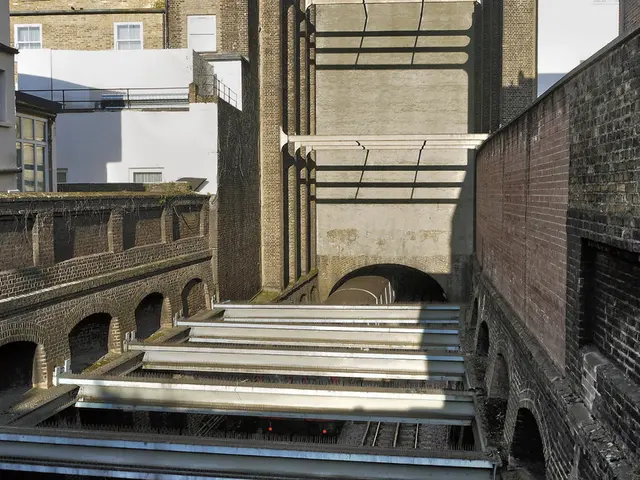Potential European water regulations for cloud service providers?
The European Union (EU) is taking decisive steps to ensure equitable access to clean water and sustainably manage its supply by focusing on the water consumption of data centers, a sector that already accounts for 42% of the digital sector's carbon footprint, according to a study by Hubblo [5].
The EU's regulatory approach is a blend of mandatory reporting, performance standards, and technological innovation promotion. The Energy Efficiency Directive (EED) requires data centers with significant power demand to annually report energy and water usage data, promoting transparency and enabling better regulatory oversight [3][4].
The European Commission is also working on future water norms that concern cloud actors, aiming to establish minimum performance standards specifically targeting overall sustainability, including water consumption efficiency [1]. This involves investments in new cooling technologies like liquid cooling, aimed at reducing water use in data centers.
Cloud Infrastructure Providers in Europe (CISPE), representing the sector, are emphasizing their role as responsible water users and innovators in better water management. They have urged the EU not to impose overly restrictive regulations solely targeting data centers, highlighting existing efforts like the Climate Neutral Data Centre Pact, which includes measuring Water Usage Effectiveness (WUE) [1].
CISPE's key recommendations to the EU Commission regarding water sustainability in data centers include establishing a formal EU framework to support industrial water reuse and return schemes, creating incentives and funding mechanisms for modernization of water systems, encouraging cloud-based digital water management solutions, and ensuring a coherent water resilience framework across all industries [2].
Leading cloud providers like AWS and Microsoft are pursuing innovative solutions, including projects that reclaim and return more water to communities and designs that use no water for cooling [1].
CISPE's report, "Advancing water resilience through digital innovation and responsible stewardship," submitted to the Commission, also highlights the importance of digital water management solutions that integrate technologies such as digital twins, AI analytics, and IoT sensors for accurate leak detection, water waste reduction, treatment optimization, and proactive environmental responses [6].
The European Water Resilience Strategy, mentioned in the article, provides a comprehensive framework for addressing water challenges in the EU, including data centers [7].
ADEME has provided an expert opinion on data centers or data processing centers, contributing to the ongoing discussions on sustainable water management in the sector [8].
In summary, the EU's approach to sustainable water management in data centers is a balanced one, combining mandatory reporting, performance standards, and technological innovation promotion, while CISPE recommends a balanced approach with reuse frameworks, incentives for modernization, digital management tools, and regulatory coherence.
This synthesis is based on recent developments from July 2025 and maintains focus on credible EU legislative documents and CISPE’s official policy statements [1][2][3][4][6].
[1] CISPE (2025). "Advancing water resilience through digital innovation and responsible stewardship". Retrieved from https://www.cispe.org/water-resilience-report
[2] CISPE (2025). "CISPE recommendations to the European Commission on water sustainability in data centers". Retrieved from https://www.cispe.org/water-sustainability-recommendations
[3] European Commission (2012). Energy Efficiency Directive. Retrieved from https://ec.europa.eu/energy/en/topics/energy-efficiency/energy-efficiency-directive
[4] European Commission (2025). "Proposal for a Regulation of the European Parliament and of the Council on the Energy Efficiency of Data Centers". Retrieved from https://ec.europa.eu/info/law/better-regulation/have-your-say/initiatives/12623-Data-Centers-Energy-Efficiency-Regulation
[5] Hubblo (2025). "Data centers' carbon footprint and water consumption: A comprehensive study". Retrieved from https://hubblo.org/water-consumption-study
[6] CISPE (2025). "Advancing water resilience through digital innovation and responsible stewardship". Retrieved from https://www.cispe.org/water-resilience-report
[7] European Commission (2020). European Water Resilience Strategy. Retrieved from https://ec.europa.eu/info/strategy/priorities-2019-2024/europe-fit-for-the-digital-age/digital-single-market/water-resilience-strategy_en
[8] ADEME (2025). Expert opinion on data centers or data processing centers. Retrieved from https://ademe.fr/expert-opinion-on-data-centers-or-data-processing-centers
- The European Commission is encouraging investments in new cooling technologies, like liquid cooling, as part of their efforts to reduce water use in data centers, which account for a significant portion of the digital sector's carbon footprint.
- Cloud Infrastructure Providers in Europe (CISPE) have urged the EU not to impose overly restrictive regulations on data centers, as they emphasize their role in environmental-science through responsible water management and innovative solutions, such as projects that reclaim and return water to communities.
- The European Water Resilience Strategy includes a comprehensive framework for addressing water challenges across industries, including data centers, focusing on aspects like water consumption efficiency, industrial water reuse, and digital water management solutions.
- To address sustainability concerns, the EU's approach includes establishing incentives and funding mechanisms for modernization of water systems, promoting technology advancements in data-and-cloud-computing (like digital twins, AI analytics, and IoT sensors), and ensuring coherent water resilience frameworks across all industries.




